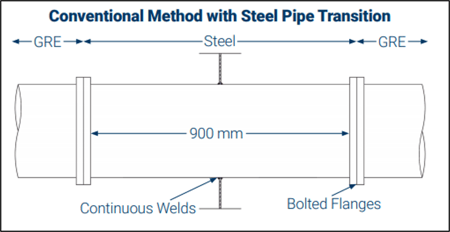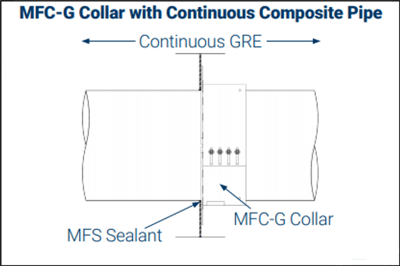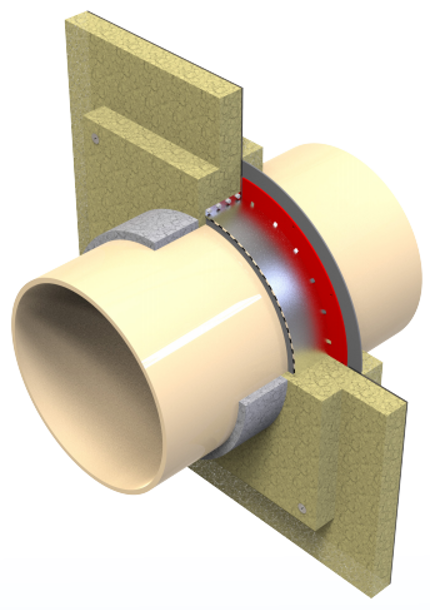Technical Bulletin – Use of Large Diameter Firestop Collars for Scrubber Upgrades with FRP/GRE/GRP Pipes
Technical Bulletin – 16320-01
Use of Large Diameter Firestop Collars for Scrubber Upgrades with FRP/GRE/GRP Pipes. Insight into Various Type Approval Agency Interpretations Concerning Use
The International Maritime Organization’s (IMO) effort to reduce the global Sulphur limit and impose stricter Sulphur limits in the Sulphur Emission Control Areas (SECAs) has led to extensive use of Exhaust Gas Cleaning systems (EGCS), often referred to as “scrubber systems”. These systems frequently use large diameter composite (FRP/GRE/GRP) pipes, which often penetrate fire-rated divisions.
There are two basic methods to address these types of penetrations. The traditional method uses an interpretation of the International Convention for the Safety of Life at Sea (SOLAS). The regulation states that no testing is required if a steel pipe is used at the penetration for a length not less than 900mm. For this method, the steel pipe is continuously welded to the division and there is therefore no need for any additional protection (See Figure 1).

Figure 1
This method is very expensive and requires periodic maintenance or replacement of the steel pipe section and valves due to the corrosion from salt water and sulfuric acid that passes through it. The second method uses a firestop collar to allow the composite pipe to breach the fire-rated division continuously without interruption or transition to steel pipe (See Figure 2).

Figure 2
This method is less expensive, and easier to install than the traditional method. It also has other additional benefits. It reduces the number of composite pipe sections and coupling flanges to be used, requires no maintenance, is lighter weight than the traditional method and can be done independent of the pipe installation which eliminates staging conflicts during the construction. STI Marine Firestop introduced the MFC-G Large Diameter FRP/GRE/GRP Firestop Collar solution several years ago, and it has gained in popularity. This solution has been fire tested to the 2010 IMO FTP code, Annex 1, Part 3, and covers pipe penetrations in A-0 through A-60 steel bulkheads and decks with an outer diameter up to 1095mm. Separate watertightness and gastightness testing has also been conducted to DNV-GL-CP-0165 for pipes with an outer diameter up to 725.8mm. This coverage may vary slightly from agency to agency but is available from ABS, BV, DNV-GL, Lloyd’s, RINA and USCG.
There are clearly great benefits to the use of our STI Marine Firestop MFC-G Large Diameter FRP/GRE/GRP Firestop Collars. But, they may not always be suitable for use dependent upon the agency and/or surveyor’s interpretation of SOLAS. Prior to purchasing the products, we encourage that the end user check with the appropriate agency since these penetrations may be subject to a separate examination and approval (water tightness after a standard fire test) per SOLAS II-1 Reg. 13.2.3. This regulation is intended for “heat-sensitive” pipes and addresses concerns of progressive flooding through the pipe or pipe penetration. Some agencies and surveyors consider FRP/GRE/GRP pipes to be “heat sensitive” while others do not, and therefore, it is important to consult with the agency or surveyor prior to installation. Due to the lack of clarity concerning interpretation, we see both agencies that approve the use of the firestop collar system and agencies that expressly reject the use of firestop collars in favor of the traditional method. Even when an individual agency may accept the use of firestop collars, an individual surveyor may not approve it, so it is best to check for compliance before making the purchase.
We trust that this information will prove helpful. Should further questions arise, please do not hesitate to contact the undersigned.
Issued by,
Julio Lopes (ext. 1034)
Sr. Engineering Manager







